A Water Feature For Every Garden
Famous gardens incorporate water as an essential element of their design. Think of Monet’s Garden in Giverny with its iconic pond and stunning water lilies, the gardens at Alhambra with their mosaic tiled riverlets throughout, the multitude of fountains at Versailles, the ponds at Kew Garden and the central Japanese garden pond at Butchart Gardens—-these fabulous gardens would simply not be the same without their integral water features.
The Why of Incorporating Water Elements in Our Gardens
Landscape architects have understood for hundreds of years that harnessing the power and beauty of this fundamental element could create tranquil and visually stunning outdoor spaces, a veritable feast for the senses.
- With the sense of sound,, whether you are trying to camouflage road noise or are just wanting to appreciate soul soothing peace, the sound of running water can help create this.
- With sight, the mesmerizing movement and reflections in water can create a visually captivating experience that lingers.
- With the sense of touch, the ability to interact with water, whether it’s dipping your hands in a fountain or wading in a shallow pond or stream, an immersive tactile element is added.
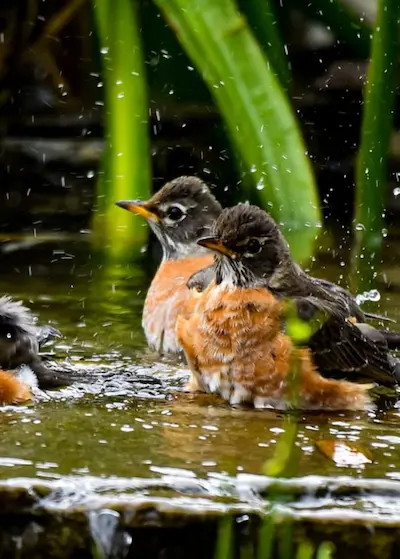
The How of Choosing a Water Feature.
Site
Consider the size, layout, and exposure of your garden when selecting a water feature, as many water plants require sun to flourish, while some shade will prevent algae bloom in the water. Also avoid building your pond in lowest lying areas of the garden as this may cause problems with flooding and runoff, especially in the spring.
Wind
Avoid areas with high wind gusts, which can disrupt the water flow, especially in fountains. This can cause overflow splashing which, in turn, can deplete the water level in the water feature, requiring frequent water top up.
Tree Canopy
Try to ensure the water feature is not overly shadowed by large trees or structures. There will be less maintenance required from leaf fall, tree seeds and branch debris.
There are a Multitude of Choices when It Comes to Water Features:
Basins
A simple basin or fountain can add a refined touch to a small space and may be connected to an outdoor electrical plug. Many shapes and materials can used very creatively.
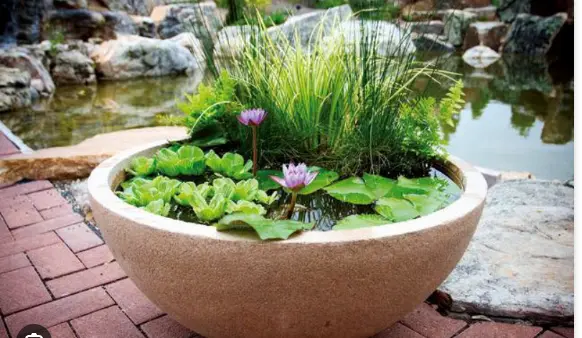
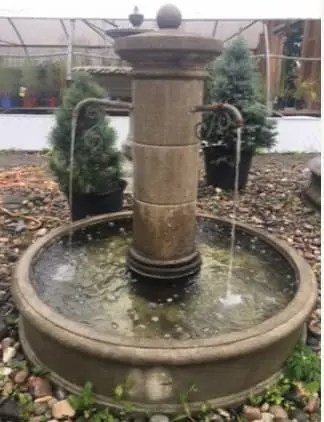
Bubbling Rocks
A beautiful, multicoloured granite bubbling rock feature can create a soothing, natural-looking water source and can be adjusted in height to give more or less splash.
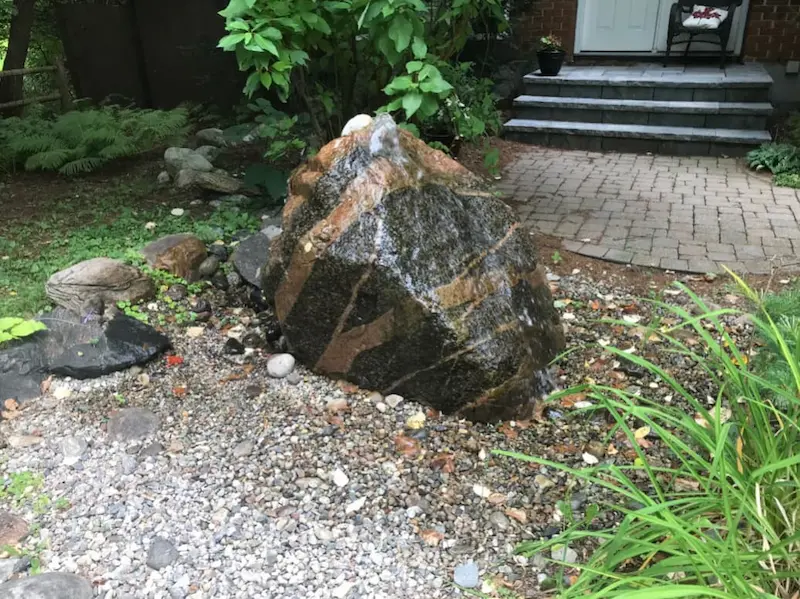
Pondless Waterfalls
A pondless waterfall is a great option for all sizes of yard and can be created anywhere—along a garden path, in an unused corner of the yard, in a flowerbed, and even in an entrance way or on a patio. It can provide the visual, tactile, and auditory appeal of a waterfall without the maintenance and security concerns of a traditional pond. This is truly an excellent water feature solution for all sizes of gardens.
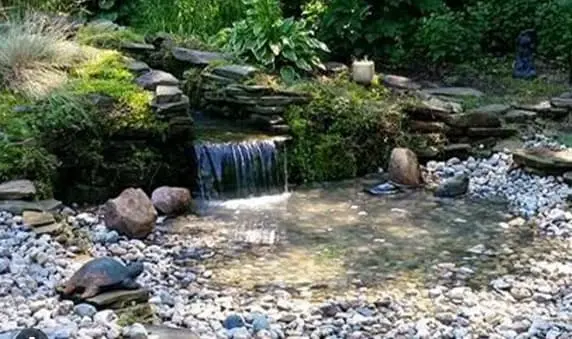
Bog Garden
A bog garden is simply a consistently wet area of the garden. It may also have a rubber lined cavity that keeps moist throughout the year. Marginals that like their feet wet, like cardinal plants and marsh marigolds, are excellent choices for Bog gardens.
Streams
A meandering stream can add visual interest and guide the eye through a larger garden, while connecting several areas of the yard, making it feel more alive. A stream can also create an exciting environment for wildlife, especially birds who may want to drink and bathe in gently moving water.
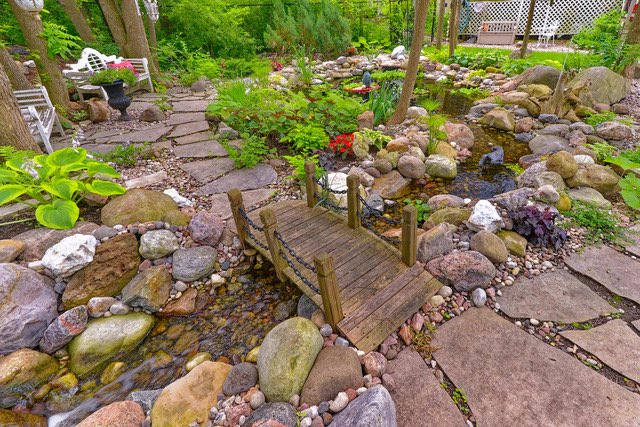
Ponds
A pond, large, small or in-between, can become the major focal point of a garden, attracting wildlife, especially frogs, toads and dragonflies, and reflecting the surrounding landscape throughout the changing seasons.
Practical Considerations for Creating Water Features
Carefully integrating a stream and pond in a garden design can create a harmonious and natural-looking water feature with many benefits to humans and animals alike.
Budget
The upfront costs of a water feature should be considered as well as possible ongoing maintenance costs. And while smaller water features like basins, fountains and pondless waterfalls can be installed relatively easily by a knowledgeable homeowner, larger ponds with streams or waterfalls should be the domain of professionals and, of course will be more expensive.
Power and Plumbing
Ensure you have the crucial electrical and plumbing infrastructure to support your type of water feature. For most water elements that are any distance from electrical outlets, a licensed electrician is recommended.
Maintenance
Factor in some regular cleaning, water monitoring, and possible potential repairs to keep your water feature functioning properly, especially where plants and fish are included.
Lighting
Whether it is a three tiered fountain, a basin on the balcony, a rambling stream or a pondless waterfall, lighting can illuminate the magical qualities of water after dark. Underwater uplighting, using halogen submersible lights, can result in glistening water and shimmering light, highlighting fish and aquatic plants, especially through moving water. Spotlights at the base of a bubbling rock or fountain can make the feature more visible while also diffusing light for a magical nightscape. Lighting options for water features today can provide endless opportunities to showcase the beauty of water, but one should remember to not overdo the lighting—- a subtle effect is much more pleasing.
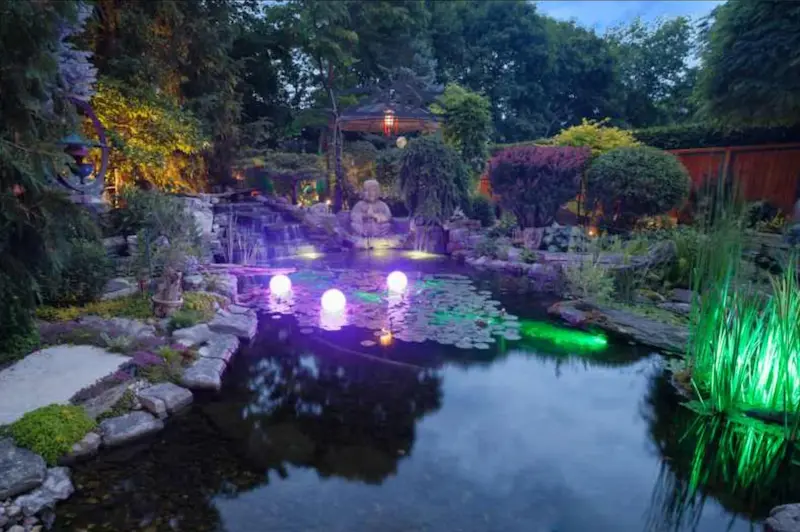
Plants
We all have pretty annuals and perennials in our gardens, but aquatic plants, whether displayed in a tiny pond, a large planter or half a whiskey barrel—make any garden feel even more complex and complete. And aquatic plants aren’t just about interesting good looks. They act as natural water filters, oxygenate water, give places for fish to hide and remove excess nutrients which helps control algae growth in water features. Aquatic plants also provide food, shade and protection for wildlife that live in and around the pond. There are several types:
- Floating plants that remain on the water’s surface; water hyacinths and water lettuce are examples.
- Marginal or bog plants that flourish with seven cm of water over their crown; corkscrew rush, creeping jenny and cardinal flowers are examples.
- Submerged plants, called oxgenators, and deep water plants can survive under four to six feet of water; water lilies and hornwort are examples.
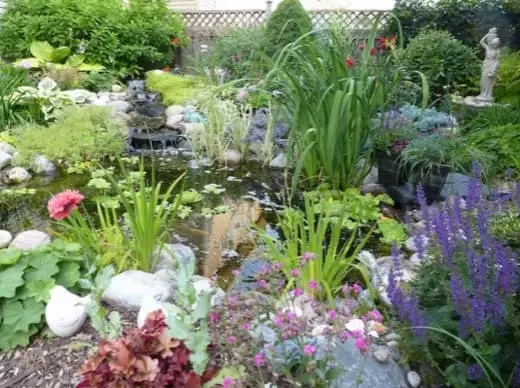
For plant ideas, go to our plant selection page and under “Soil”, pick ‘Wet” and ‘Moist”
Fish and Wildlife
Fish are considered to be the crowning glory of a pond. Koi and goldfish can be multicoloured and grow quite large. They add extra vitality —flashing and jumping and can provide great entertainment for guests at feeding time. There are good practives for keeping a healthy koi pond. Water features can draw a wide variety of wildlife, including birds, insects, mammals, amphibians, and invertebrates. A small fountain or a bubbling boulder can provide drinking water for all sorts of wildlife. Moving water, however, will attract more creatures to the garden than still water, especially birds who love to bathe and splash in the glistening water.
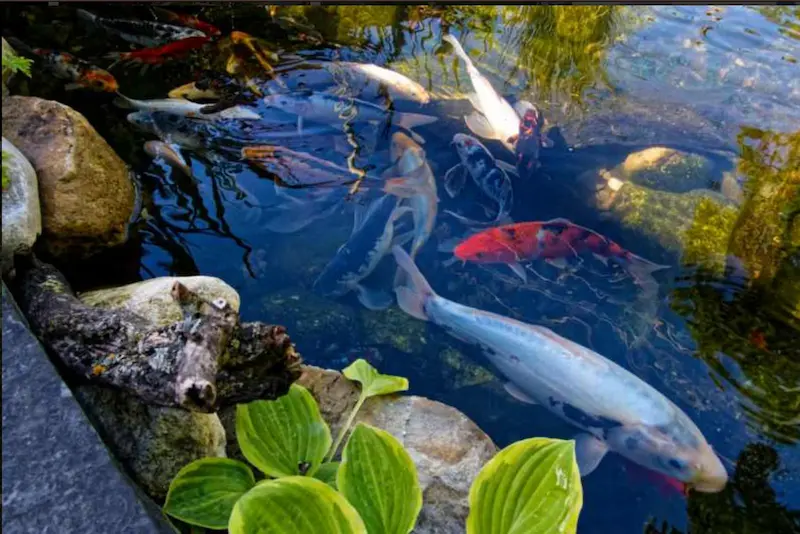
Art with Water Features
The manipulation of water can be an art form in its own right, spouting or cascading with deliberate design. Historically, the link between water features and art was very clear. The famous Trevi fountain in Rome and the fountains at Versailles are perfect examples of the water feature itself as art and are tied together in so many ways the line between the two is practically nonexistent. Of course, with today’s water features, even the most basic basin or fountain can be a form of creative expression. These are two of the photos from local gardens selected from the 2024 Ottawa Water Garden tour.
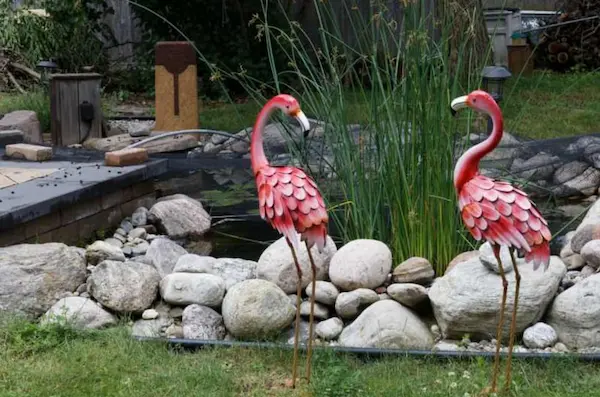
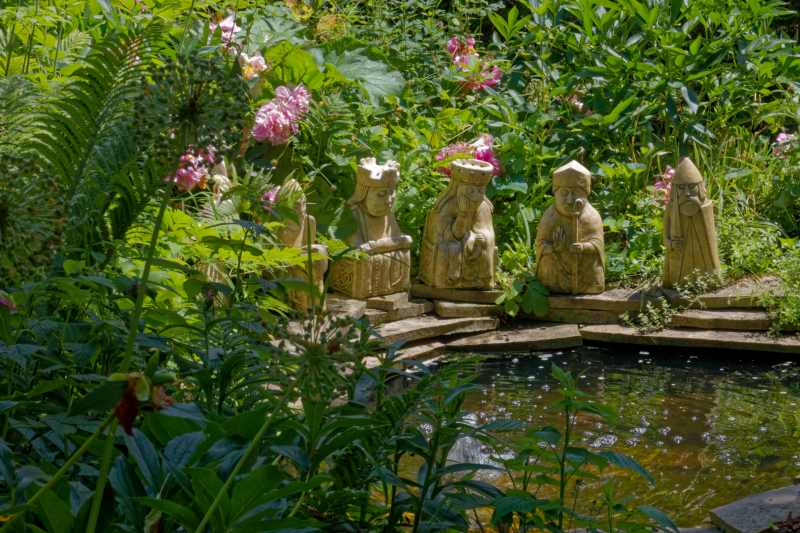
Installing a Water Feature
The installation of water features like small fountains, basins and container ponds can be quite simple and straightforward. In a smaller space a wall fountain which recirculates water into a basin can be purchased premade. Ready-to-plug-in-kits are available for a wide variety of basin type water features, including with different sized pumps that create less or more water flow. Pond installations are also easier than one might think. A purchased pre-formed plasticized pond shell is easy to embed in the ground and with the addition of a small pump, a cascading waterfall can be created. A specialized rubber liner can be added to a dug out area, overlapping the sides. Smaller stones and larger rocks can be arranged in the bottom and along the sides of the pond for a more natural look. With the addition of aquatic plants in and around the water feature, you and wildlife will be delighted.
Conclusion
In conclusion, whatever water feature chosen for your garden will provide:
- Soothing sounds: The gentle sounds of a water feature create a calming and restorative atmosphere in your garden.
- Visual appeal: A well-designed water feature, whatever size, can become a stunning focal point, enhancing the overall aesthetics of your outdoor garden space.
- Harmonious integration: When thoughtfully incorporated, a water feature can seamlessly blend with the surrounding landscape, creating a cohesive and tranquil garden design that brings together water, wildlife and your delight.







Leave a Reply
You must be logged in to post a comment.